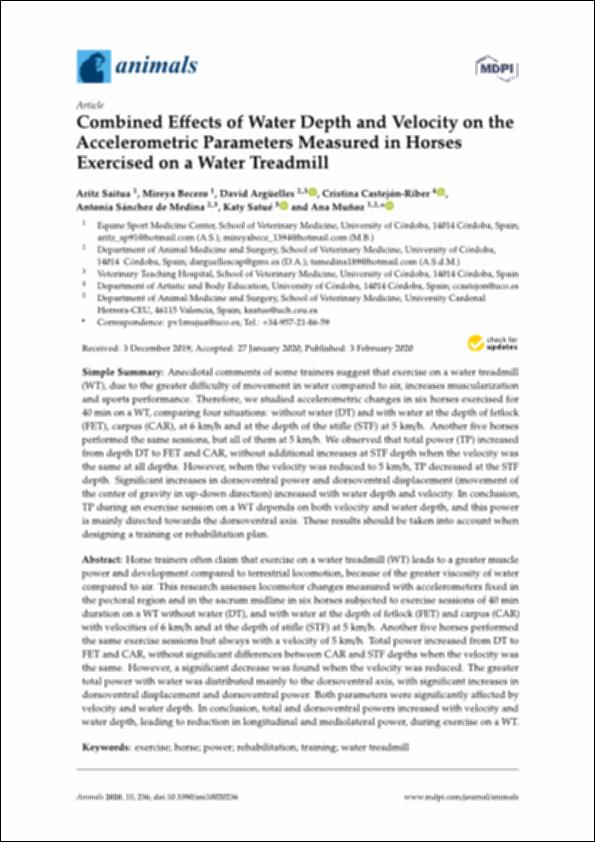Please use this identifier to cite or link to this item:
http://hdl.handle.net/10637/12538Combined effects of water depth and velocity on the accelerometric parameters measured in horses exercised on a water treadmill
| Title: | Combined effects of water depth and velocity on the accelerometric parameters measured in horses exercised on a water treadmill |
| Authors : | Saitua Penas, Aritz Becero López, Mireya Argüelles Capilla, David Castejón Riber, Cristina Sánchez de Medina, Antonia Satué Ambrojo, Katiuska Muñoz Juzado, Ana |
| Keywords: | Hidroterapia.; Hydrotherapy.; Caballos - Adiestramiento.; Caballos de carrera y trote - Rehabilitación.; Race horses - Rehabilitation.; Horses - Training. |
| Publisher: | MDPI |
| Citation: | Saitua, A., Becero, M., Argüelles, D., Castejón-Riber, C., Sánchez de Medina, A., et al. (2020). Combined effects of water depth and velocity on the accelerometric parameters measured in horses exercised on a water treadmill. Animals, vol. 10, i. 2 (03 feb.), art. 236. DOI: https://doi.org/10.3390/ani10020236 |
| Abstract: | Horse trainers often claim that exercise on a water treadmill (WT) leads to a greater muscle power and development compared to terrestrial locomotion, because of the greater viscosity of water compared to air. This research assesses locomotor changes measured with accelerometers fixed in the pectoral region and in the sacrum midline in six horses subjected to exercise sessions of 40 min duration on a WT without water (DT), and with water at the depth of fetlock (FET) and carpus (CAR) with velocities of 6 km/h and at the depth of stifle (STF) at 5 km/h. Another five horses performed the same exercise sessions but always with a velocity of 5 km/h. Total power increased from DT to FET and CAR, without significant di erences between CAR and STF depths when the velocity was the same. However, a significant decrease was found when the velocity was reduced. The greater total power with water was distributed mainly to the dorsoventral axis, with significant increases in dorsoventral displacement and dorsoventral power. Both parameters were significantly a ected by velocity and water depth. In conclusion, total and dorsoventral powers increased with velocity and water depth, leading to reduction in longitudinal and mediolateral power, during exercise on a WT. |
| Description: | Este artículo se encuentra disponible en la siguiente URL: https://www.mdpi.com/2076-2615/10/2/236 Este artículo pertenece al número especial "The horse as an athlete: sports medicine, rehabilitation and wellness". |
| URI: | http://hdl.handle.net/10637/12538 |
| Rights : | http://creativecommons.org/licenses/by/4.0/deed.es |
| ISSN: | 2076-2615 (Electrónico). |
| Issue Date: | 3-Feb-2020 |
| Center : | Universidad Cardenal Herrera-CEU |
| Appears in Collections: | Dpto. Medicina y Cirugía Animal |
Items in DSpace are protected by copyright, with all rights reserved, unless otherwise indicated.


